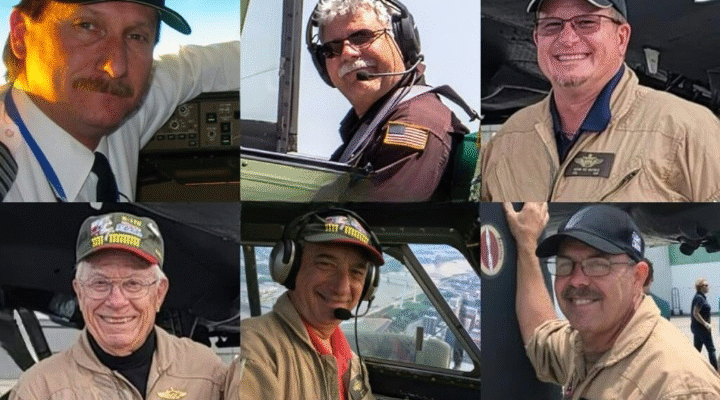Wings Over Dallas: Remembering a Historic Airshow and the Lessons That Followedon Wings Over Dallas: Remembering a Historic Airshow and the Lessons That Followed
Airshows have long been a blend of inspiration, history, and technical brilliance. They bring to life the legacy of aviation, offering spectators a front-row seat to aircraft that once shaped the course of world events. Each event celebrates not only machinery but also the people who dedicate their lives to preserving aviation heritage.
The Wings Over Dallas Airshow—a yearly event honoring World War II history—was expected to be a weekend filled with pride and admiration for those who served. Pilots, engineers, and volunteers had prepared for months, ensuring every engine, wing, and maneuver reflected the excellence of flight. But in 2022, what began as a day of tribute and community suddenly turned into a moment of deep reflection for the aviation world.
A Celebration of Flight and History
The event took place at Dallas Executive Airport, a hub for aviation enthusiasts from across the nation. Families arrived early, children holding miniature model planes, veterans wearing caps embroidered with squadron numbers, and photographers setting up their lenses to capture history in motion.
At its heart, Wings Over Dallas is more than an exhibition; it is an educational experience designed to remind younger generations of the courage, skill, and innovation that defined World War II aviation. The Commemorative Air Force (CAF)—a nonprofit organization that restores and maintains historic aircraft—plays a central role in these displays. Each plane, lovingly restored, tells a story of dedication and teamwork.
That November afternoon, conditions seemed ideal. The Texas sky was clear, the crowd cheerful, and anticipation grew as the next formation flight was announced—one featuring aircraft that once represented two different types of wartime aviation: bombers and fighters.
The Aircraft and Their Meaning
Two historically significant aircraft were scheduled for the demonstration:
-
The Boeing B-17 Flying Fortress, a four-engine heavy bomber known for its resilience and service in long missions during the war. It symbolized endurance, teamwork, and protection.
-
The Bell P-63 Kingcobra, a sleek single-engine fighter celebrated for its speed and precision. It represented agility, innovation, and air-superiority tactics of the 1940s.
For many spectators, seeing these planes together was a rare opportunity—a visual connection to a past era when aviation was both a tool of defense and a marvel of engineering.
An Afternoon That Changed Everything
During the formation display, the two aircraft unexpectedly collided in midair. Within moments, the joyful noise of engines and applause was replaced by stunned silence.
Emergency personnel responded immediately, securing the area and assisting attendees. The Federal Aviation Administration (FAA) and the National Transportation Safety Board (NTSB) launched comprehensive investigations to determine exactly how the event unfolded.
In the hours that followed, local authorities confirmed that six crew members aboard the planes lost their lives. Each was a deeply experienced aviator and volunteer dedicated to preserving the memory of aviation’s golden age. The news sent shockwaves through aviation circles nationwide and left the Dallas community mourning individuals who had contributed immensely to public education and historical preservation.
Honoring the Lives Behind the Flight
The six men who participated in the flight were not only skilled pilots and crew; they were mentors, veterans, and family members. Their shared mission was to educate, inspire, and connect people to aviation history.
Terry Barker
A retired American Airlines pilot and former city council member, known for calm leadership and lifelong commitment to public service.
Leonard “Len” Root
Also a retired airline pilot, admired for professionalism and mentoring younger aviators.
Craig Hutain
A Houston-based pilot who brought joy to spectators through his precision flying and love for aircraft demonstration.
Kevin Michels, Dan Ragan, and Curt Rowe
Members of the Commemorative Air Force, each contributing thousands of volunteer hours to restoration, maintenance, and education.
Their loss left a void not only within their families but throughout the aviation community. Memorials were held across Texas to celebrate their contributions and to reaffirm the values of courage and dedication that define flight.
The Investigation: Searching for Understanding
The NTSB began its inquiry within hours of the event. Investigators collected debris, reviewed witness statements, and analyzed public videos that captured different angles of the flight. Because these vintage aircraft were built before modern data-recording technology existed, officials sought alternative sources of information.
Recovered devices included:
-
An electronic flight display from the B-17
-
A GPS unit from the P-63
Both were sent to Washington, D.C., for detailed examination. These tools can provide data about altitude, heading, and engine performance in the seconds before impact.
Officials emphasized that investigations of this complexity take time—often a year or more—because each variable must be analyzed meticulously: flight plans, pilot communication, weather patterns, and formation choreography.
Preliminary findings suggested that visibility, altitude spacing, and formation geometry were key factors under review. The goal was not to assign blame but to learn from the incident and improve future safety practices.
Why Flying Vintage Aircraft Is Different
Operating historic planes requires extraordinary skill and constant maintenance. Unlike modern airliners equipped with redundant systems and advanced automation, World War II aircraft rely heavily on manual control and mechanical integrity.
Key challenges include:
-
Aging materials that must be inspected frequently for fatigue
-
Unique handling characteristics—no two vintage planes behave identically
-
Limited modern avionics—many rely on analog gauges rather than digital flight systems
-
Complex coordination during formation flying
Pilots in these shows undergo specialized training and are often certified by organizations such as the CAF Safety Council. Despite extensive preparation, the margin for error in such demonstrations remains narrow. Airshows worldwide therefore maintain strict operational rules—designated altitudes, flight paths, and safety buffers—to minimize risk.
Balancing Heritage and Safety
After the Dallas tragedy, aviation experts and event organizers revisited a central question: How can the preservation of history coexist with modern safety expectations?
Some proposed implementing enhanced spacing rules during formation displays, while others suggested adapting lightweight collision-avoidance systems to vintage cockpits without compromising authenticity. Event planners also began re-evaluating airshow choreography to prioritize vertical separation rather than close-proximity formations.
Aviation historian Dr. Elena Porter summarized it aptly in a post-incident symposium:
“The purpose of these exhibitions is to inspire. History should lift us, not endanger us. The challenge is to honor heritage responsibly—with reverence, precision, and care.”
Her remarks echoed throughout the industry, reinforcing the principle that educational flight demonstrations must evolve with time and technology.
Community Response and Support
In the weeks following the event, memorial ceremonies took place at airports, museums, and aviation schools. The CAF established a fund to support the families of the crew and to advance new safety programs. Thousands of people contributed, leaving heartfelt messages celebrating the pilots’ commitment to preserving the past.
Local schools hosted educational sessions explaining both the importance of aviation history and the science of flight safety. These initiatives aimed to turn sorrow into learning—a legacy the pilots themselves would have endorsed.
Across social media, expressions of sympathy and respect far outweighed speculation. Many attendees shared stories of how the event had inspired them or their children to learn more about engineering, aerodynamics, or military service.
The Psychological Impact
Witnessing an unexpected aviation accident can be emotionally overwhelming. Mental-health professionals partnered with the Red Cross and community centers to offer counseling for those affected, emphasizing that trauma reactions are normal after shocking events.
Parents who attended with children were encouraged to discuss what happened calmly, focusing on the bravery and professionalism of the pilots rather than the incident itself. Such discussions help young minds process fear through understanding rather than anxiety.
Learning From the Past
Aviation has always advanced through learning. Each incident, no matter how painful, yields data and insights that enhance safety worldwide. Following the Wings Over Dallas investigation, several organizations began implementing improvements:
-
Updated flight-briefing protocols to clarify formation roles and altitude separation
-
Enhanced communication procedures using discrete radio channels
-
Digital modeling tools to visualize choreography before live performances
-
Mandatory safety refresher training for all participating crews
These initiatives ensure that the legacy of the six aviators translates into safer skies for future generations.
Preserving the Legacy of Flight
Despite the tragedy, the mission to preserve aviation history continues. Restorers, engineers, and volunteers across the country are working to maintain the aircraft that remain—a living tribute to technological progress and human determination.
Museums and airshows have adopted new educational formats emphasizing static displays, virtual-reality flight simulators, and interactive exhibits that convey the power and beauty of historic aviation without requiring every aircraft to take flight.
The Wings Over Dallas community has also pledged to carry forward an annual day of remembrance celebrating the pilots’ lives and encouraging young people to pursue careers in aviation, engineering, and public service.
Broader Lessons for Aviation Safety
Every sector of aviation—commercial, private, and historical—shares a single responsibility: continuous improvement. The Dallas event reinforced several universal truths:
-
Technology evolves, but vigilance must remain constant.
Even as sensors and AI assist modern aircraft, human oversight remains essential. -
Training saves lives.
Simulation-based rehearsals and transparent communication among teams can prevent critical misunderstandings. -
Public education matters.
Spectators who understand safety boundaries contribute to responsible airshow culture. -
Respect for history requires responsibility.
Preserving machinery from the past must never outweigh the value of human life today.
These insights are shaping policies not just in the United States but in aviation communities around the world.
A Legacy of Courage and Dedication
The six airmen lost at Wings Over Dallas shared one common dream: to make history come alive. Their passion transcended personal recognition; it was about connecting people—especially younger generations—to the marvel of flight.
Their dedication reminds us that aviation is built on curiosity, courage, and community. From the earliest pioneers to today’s aviators, each generation inherits both the achievements and the responsibilities of those who came before.
Through ongoing education, enhanced safety measures, and respect for the skies, their memory continues to guide the course of aviation’s future.
Conclusion: Moving Forward With Purpose
The Wings Over Dallas tragedy will forever stand as a solemn chapter in aviation history. Yet, it also serves as a catalyst for growth—a moment when the global aviation community reaffirmed its dedication to safety, transparency, and education.
In honoring those who were lost, professionals and enthusiasts alike have renewed their commitment to innovation and care. The story of that day, though painful, underscores a timeless truth: humanity’s pursuit of flight is not just about reaching the skies, but about learning, adapting, and safeguarding each other along the way.
As restoration hangars hum once again and children gaze upward at airshows across the country, the message endures—history can continue to soar, safely and with reverence, because of those who devoted their lives to keeping its spirit alive.



